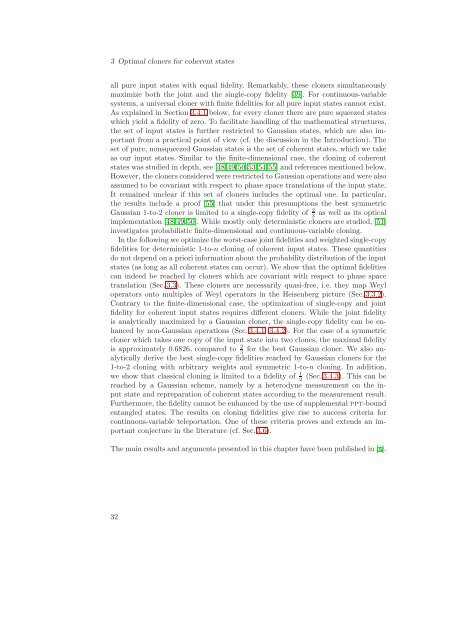Quantum Information Theory with Gaussian Systems
Quantum Information Theory with Gaussian Systems
Quantum Information Theory with Gaussian Systems
Create successful ePaper yourself
Turn your PDF publications into a flip-book with our unique Google optimized e-Paper software.
3 Optimal cloners for coherent states<br />
all pure input states <strong>with</strong> equal fidelity. Remarkably, these cloners simultaneously<br />
maximize both the joint and the single-copy fidelity [39]. For continuous-variable<br />
systems, a universal cloner <strong>with</strong> finite fidelities for all pure input states cannot exist.<br />
As explained in Section 3.4.1 below, for every cloner there are pure squeezed states<br />
which yield a fidelity of zero. To facilitate handling of the mathematical structures,<br />
the set of input states is further restricted to <strong>Gaussian</strong> states, which are also important<br />
from a practical point of view (cf. the discussion in the Introduction). The<br />
set of pure, nonsqueezed <strong>Gaussian</strong> states is the set of coherent states, which we take<br />
as our input states. Similar to the finite-dimensional case, the cloning of coherent<br />
states was studied in depth, see [48,49,50,53,54,55] and references mentioned below.<br />
However, the cloners considered were restricted to <strong>Gaussian</strong> operations and were also<br />
assumed to be covariant <strong>with</strong> respect to phase space translations of the input state.<br />
It remained unclear if this set of cloners includes the optimal one. In particular,<br />
the results include a proof [55] that under this presumptions the best symmetric<br />
<strong>Gaussian</strong> 1-to-2 cloner is limited to a single-copy fidelity of 2<br />
3<br />
as well as its optical<br />
implementation [48,49,50]. While mostly only deterministic cloners are studied, [51]<br />
investigates probabilistic finite-dimensional and continuous-variable cloning.<br />
In the following we optimize the worst-case joint fidelities and weighted single-copy<br />
fidelities for deterministic 1-to-n cloning of coherent input states. These quantities<br />
do not depend on a priori information about the probability distribution of the input<br />
states (as long as all coherent states can occur). We show that the optimal fidelities<br />
can indeed be reached by cloners which are covariant <strong>with</strong> respect to phase space<br />
translation (Sec. 3.3). These cloners are necessarily quasi-free, i.e. they map Weyl<br />
operators onto multiples of Weyl operators in the Heisenberg picture (Sec. 3.3.2).<br />
Contrary to the finite-dimensional case, the optimization of single-copy and joint<br />
fidelity for coherent input states requires different cloners. While the joint fidelity<br />
is analytically maximized by a <strong>Gaussian</strong> cloner, the single-copy fidelity can be enhanced<br />
by non-<strong>Gaussian</strong> operations (Sec. 3.4.1, 3.4.2). For the case of a symmetric<br />
cloner which takes one copy of the input state into two clones, the maximal fidelity<br />
is approximately 0.6826, compared to 2<br />
3 for the best <strong>Gaussian</strong> cloner. We also analytically<br />
derive the best single-copy fidelities reached by <strong>Gaussian</strong> cloners for the<br />
1-to-2 cloning <strong>with</strong> arbitrary weights and symmetric 1-to-n cloning. In addition,<br />
we show that classical cloning is limited to a fidelity of 1<br />
2<br />
(Sec. 3.4.3). This can be<br />
reached by a <strong>Gaussian</strong> scheme, namely by a heterodyne measurement on the input<br />
state and repreparation of coherent states according to the measurement result.<br />
Furthermore, the fidelity cannot be enhanced by the use of supplemental ppt-bound<br />
entangled states. The results on cloning fidelities give rise to success criteria for<br />
continuous-variable teleportation. One of these criteria proves and extends an important<br />
conjecture in the literature (cf. Sec. 3.6).<br />
The main results and arguments presented in this chapter have been published in [a].<br />
32
















